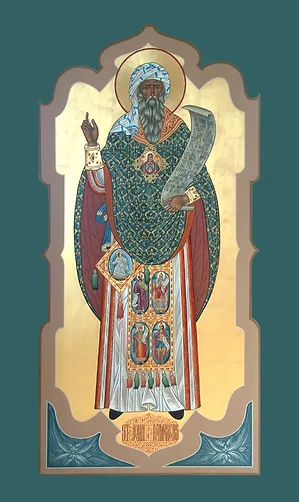This post was originally published on this site
Introduction
This month, we are learning to “walk in the Light” with Saint John of Damascus. Saint John had a true devotion to Christ and His Church as he defended the faith against the heresy of iconoclasm that was ever present during his time. Saint John shows us that there is a dimension to iconography that reveals the true light of our salvation—Jesus Christ. Today, we will use his writings to explore icons as “the window of heaven” through which the Light that springs from the Holy Trinity can be revealed.
Before our discussion begins, let’s have 120 seconds of silence.
Take this chance to come into the presence of God and His saints as a group. Sit still. Breathe slowly and deeply. Say the Jesus prayer.

Part I: Icons Communicate the Light of Christ
Reflection
Saint John of Damascus penned some of the most vital arguments in favor of icon veneration through the lens of Christology, or our understanding of who Jesus Christ is. According to Saint John, our relationship to icons unfolds from the nature of Christ, who is both fully man and fully God in one Person. The Second Person of the Trinity became incarnate, taking on flesh and therefore making the invisible God visible. Thus, icons reveal to us the Incarnate Christ—in which both humanity and divinity are manifested without confusion, division, mixture, or change.
“I make an image of the God whom I see. I do not worship matter, I worship the God of matter, who became matter for my sake, and deigned to inhabit matter, who worked out my salvation through matter. I will not cease from honoring that matter which works my salvation. I venerate it, though not as God. How could God be born out of lifeless things? And if God’s body is God by its union with him, it is changeless. The nature of God remains the same as before, the flesh created in time is brought to life by a logical and reasoning soul. I honor all matter, and venerate it. Through it, filled, as it were, with a divine power and grace, my salvation has come to me.”
Here we see Saint John conveying how the icon communicates the incarnation of Christ without leading us to worship created things. Icons are neither simply portraits nor are they idols meant to draw our attention away from the Creator, but rather, icons portray the unity of humanity with God in Christ.
Discussion Questions
- How would you summarize Saint John’s thoughts on the defense of icons, specifically looking at the difference between worship and veneration? Discuss with one another.
- Icons are unlike any painting of Picasso or Monet, as they call us to something deeper, something not of this world. How are icons a union between the visible and invisible worlds?
Part II: Icons Reveal the Goodness of Creation
Reflection
Saint John adresses the fact that the origin of icons lay in the Incarnation of Christ, as this was a sign of perfect love for the purpose of salvation for the world. In each icon, the awesomeness of God becomes accessible to our very eyes, a true way to reveal the glory of God. Let us read the words of Saint John, as they so beautifully describe the icon as it transcends the detachment between the created world and the kingdom of God.
“The invisible things of God have been made visible through images since the creation of the world. We see images in creation which remind us faintly of God, e.g. in order to talk about the holy and worshipful Trinity, we use the images of the sun and rays of light, a spring and a full river, the mind and speech and the spirit within us, or a rose tree, a sprouting flower, and a sweet fragrance.”
“I honor all matter, and venerate it. Through it, filled, as it were, with a divine power and grace, my salvation has come to me. Was the three-times happy and blessed wood of the Cross not matter? Was the sacred and holy mountain of Calvary not matter? What of the life-giving rock, the Holy Tomb, the source of our resurrection — was it not matter? Is the holy book of the Gospels not matter? Is the blessed table which gives us the Bread of Life not matter? Are the gold and silver, out of which crosses and altar-plate and chalices are made not matter? And before all these things, is not the body and blood of our Lord matter? Either stop venerating all these things, or submit to the tradition of the Church in the venerating of images, honoring God and his friends, and following in this the grace of the Holy Spirit. Do not despise matter, for it is not despicable. Nothing that God has made is.”
Here, Saint John states that we are not to despise matter.” It is true that in the Orthodox Church, we venerate icons and hold them with dear reverence. We are careful with them at all times, and do not damage them in any way. Why is this? As Saint John emphasizes, icons are images of the light of Christ, and are to be treated with great care and honor. Just as we hold icons to be matter that is venerated, we must too hold our own brothers and sisters to this same standard of honor and care, as each one of us are icons of Christ. If we are to “honor all matter and venerate it” as Saint John voices, we must be ready to honor and venerate our neighbors with the very same carefulness. Imagine if we ran and kissed our neighbors the same way we run to kiss an icon of the Theotokos. We are all created by God as a reflection of His holiness, and thus, we should treat each with that very belief, running to hug and kiss one another as we run and kiss the very icon of Christ.
Discussion Questions
- Why is it very easy to love and venerate an icon but at times, so difficult to love our neighbors?
- Saint Paisios once said “The grass is an icon; this stone is an icon; and I can kiss it, venerate it, because it is filled with God’s grace.” In today’s day and age, we see trends of neo-paganism on the one hand and rejection of physical realities on the other. What do St. John and St. Paisios teach us in regards to how we should approach the material world? How is it different from approaches you see others take?
- We are constantly being called to be ready to defend our faith at all times. If asked, how would you defend the veneration of icons in the Church?



